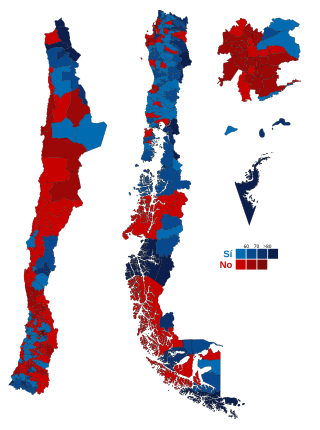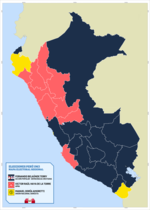The politics of the Republic of Peru takes place in a framework of a unitary semi-presidential representative democratic republic, whereby the President of Peru is both head of state and head of government, and of a pluriform multi-party system. Executive power is exercised by the President and the Government. Legislative power is vested in both the Government and the Congress. The Judiciary is independent of the executive and the legislature. The Economist Intelligence Unit rated Peru a "hybrid regime" in 2022.

The Peruvian Armed Forces are the military services of Peru, comprising independent Army, Navy and Air Force components. Their primary mission is to safeguard the country's independence, sovereignty and territorial integrity against any threat. As a secondary mission they participate in economic and social development as well as in civil defence tasks.

A military junta is a system of government led by a committee of military leaders and whose constitutional provisions are suspended. The term junta means "meeting" or "committee" and originated in the national and local junta organized by the Spanish resistance to Napoleon's invasion of Spain in 1808. The term is now used to refer to an authoritarian form of government characterized by oligarchic military dictatorship, as distinguished from other categories of authoritarian rule, specifically strongman ; machine ; and bossism.

The 1973 Chilean coup d'état was a military overthrow of the democratic socialist president of Chile Salvador Allende and his Popular Unity coalition government. Allende, who has been described as the first Marxist to be democratically elected president in a Latin American liberal democracy, faced significant social unrest, political tension with the opposition-controlled National Congress of Chile. On 11 September 1973, a group of military officers, led by General Augusto Pinochet, seized power in a coup, ending civilian rule.

Francisco Javier Arana Castro was a Guatemalan military leader and one of the three members of the revolutionary junta that ruled Guatemala from 20 October 1944 to 15 March 1945 during the early part of the Guatemalan Revolution. A major in the Guatemalan army under the dictator Jorge Ubico, he allied with a progressive faction of the army to topple Ubico's successor Federico Ponce Vaides. He led the three-man junta that oversaw the transition to a democratic government, although he was personally reluctant to allow the elected President Juan José Arévalo to take office in 1945. He served as the Chief of the Armed Forces in the new government until 1949. On 18 July 1949 he was killed in a shootout with supporters of the Arévalo government after he threatened to launch a coup.

Fernando Sergio Marcelo Marcos Belaúnde Terry was a Peruvian politician who twice served as President of Peru. Deposed by a military coup in 1968, he was re-elected in 1980 after twelve years of military rule.

José Napoleón Duarte Fuentes was a Salvadoran politician who served as President of El Salvador from 1 June 1984 to 1 June 1989. He was mayor of San Salvador before running for president in 1972. He lost, but the election is widely viewed as fraudulent. Following a coup d'état in 1979, Duarte led the subsequent civil-military Junta from 1980 to 1982. He was then elected president in 1984, defeating ARENA party leader Roberto D'Aubuisson.

Manuel Carlos Prado y Ugarteche was a Peruvian politician and banker who served twice as President of Peru. Son of former president Mariano Ignacio Prado, he was born in Lima and served as the nation's 43rd (1939–1945) and 46th (1956–1962) president. His brother, Leoncio Prado Gutiérrez, was a military hero who died in 1883, six years before Manuel Prado was born.

The history of Thailand from 1973 to 2001 saw an unstable period of democracy, with military rule being reimposed after a bloody coup in 1976.
The 1992 Peruvian self-coup, sometimes known as the Fujimorazo, was performed in Peru in 1992 after President Alberto Fujimori dissolved the Congress as well as the judiciary and assumed full legislative and judicial powers. With the collaboration of the military, the Fujimori government subsequently began to implement objectives of the Green Plan following the coup.
National Front was a period in the history of Colombia in which the two main political parties, the Liberal Party and the Conservative Party, agreed to rotate power, intercalating for a period of four presidential terms. The National Front Presidents were Alberto Lleras Camargo (Liberal), Guillermo León Valencia (Conservative), Carlos Lleras Restrepo (Liberal), and Misael Pastrana Borrero (Conservative).

A referendum on whether Augusto Pinochet, the head of a military dictatorship, should become president for eight years under resumed civilian rule was held in Chile on 5 October 1988. The "No" side won with 56% of the vote, marking the end of Pinochet's 16+1⁄2-year rule. Democratic elections were held in 1989, leading to the establishment of a new government in 1990.

The history of the Republic of Ecuador from 1960 to 1990 encompasses a period of political, social, and economic changes in the country. During this time, Ecuador experienced military regimes, political instability, social movements, and economic challenges.

The history of Bolivia from 1964 to 1982 is a time of periodic instability under various military dictators. On November 4, 1964, power passed from the elected leader of the Bolivian National Revolution, Víctor Paz Estenssoro, to a military junta under vice-president General René Barrientos. Barrientos was elected president in 1966 but died suspiciously in a helicopter crash in 1969 while touring the countryside and visiting the indigenous people of Bolivia. This led to a coup in September 1969 by General Ovando, who was overthrown in October 1970 by General Rogelio Miranda, who was overthrown a couple of days later by General Juan José Torres, who in turn was overthrown in August 1971 by Hugo Banzer Suárez. Banzer ruled for seven years, initially from 1971 to 1974, with the support of Estenssoro's Nationalist Revolutionary Movement. In 1974, impatient with schisms in the party, he replaced civilians with members of the armed forces and suspended political activities. The economy grew impressively during Banzer's presidency, but demands for greater political freedom undercut his support. He called elections in 1978, and Bolivia once again plunged into turmoil. Juan Pereda ruled for only four months in 1978, but his ascent to the presidency marked the beginning of an even more unstable period in Bolivian history, with nine civilian and military presidents in little over four years (1978–1982). 1982 marked the return to a democratically elected government, with Guido Vildoso as president.
In Argentina, there were seven coups d'état during the 20th century: in 1930, 1943, 1955, 1962, 1966, 1976, and 1981. The first four established interim dictatorships, while the fifth and sixth established dictatorships of permanent type on the model of a bureaucratic-authoritarian state. The latter two conducted a Dirty War in the line of state terrorism, in which human rights were systematically violated and there were tens of thousands of forced disappearances.
1964 Bolivian coup d'état in Bolivia was a coup under the leadership of Vice-president René Barrientos and Bolivian Army commander-in-chief Alfredo Ovando Candía against the President Víctor Paz Estenssoro, leader of the Bolivian National Revolution of 1952, who recently had been re-elected for his third term in office.
The 1979 Salvadoran coup d'état was a military coup d'état that occurred in El Salvador on 15 October 1979. The coup, led by young military officers, bloodlessly overthrew military President Carlos Humberto Romero and sent him into exile. The National Conciliation Party's firm grasp on power was cut, and in its place, the military established the Revolutionary Government Junta of El Salvador (JRG). The junta was composed of two military officers and three civilians.
The 1963 Dominican coup d'état was a coup d'état that took place on 25 September 1963 against President Juan Bosch in the Dominican Republic. Juan Bosch had been the first democratically elected president after the assassination of the former dictator Rafael Trujillo, but he faced criticism due to his policies, which were seen as leftist. This led to a coup that replaced his government with a military junta; which itself would be replaced with a civilian junta.

The 1962 Peruvian coup d'état was promoted by the then Chief of the Joint Command of the Peruvian Armed Forces, General Ricardo Pérez Godoy, against the outgoing government of Manuel Prado Ugarteche for alleged irregularities in the electoral process of that year.
















